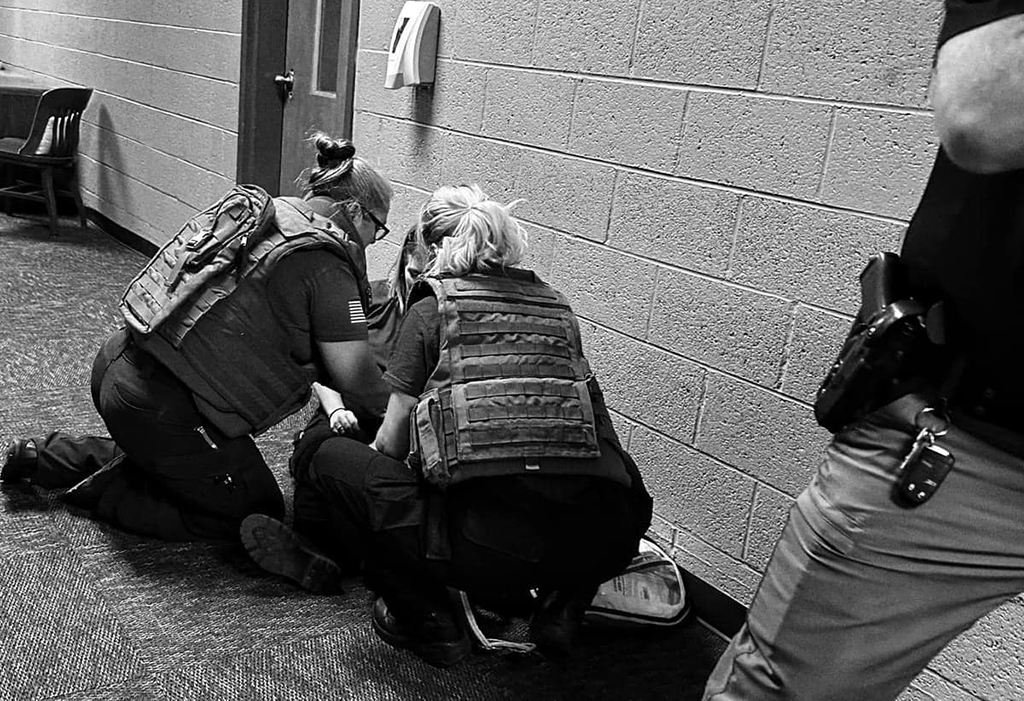The Duplin County Sheriff’s Office, in collaboration with Duplin County EMS, recently conducted rapid deployment training at the DCSO training center in Rose Hill.
The annual training, a crucial component in the readiness of both teams, is designed to prepare them for potential active shooter scenarios, bomb threats and other critical situations.
“We’re working in conjunction with each other, because we know that both our office staff and EMS are going to be on scene for critical incidents. So, we want to make sure that everybody is training on the same page,” said Ben Parrish, Duplin County Sheriff’s Office instructor, adding that their rapid deployment training falls under the rescue task force concept.

“So, instead of waiting to get victims out, we go ahead and send EMS personnel in with a security team to start evacuating wounded personnel,” said Parrish. “They’ve got what it’s called the golden hour to get treatment and we want to make sure that they get to that treatment as quickly as possible.”
The training incorporated the Kenansville Police Department as well, demonstrating a comprehensive approach to public safety. According to Parrish, the Kenansville Police Department recently took over the security of Kenansville Elementary School, and the collaboration ensures all the training is consistent across the board.
Parrish shared that the training includes two components, tactical and life-saving skills.
“We prepare our officers to confront the threat either individually or as a team as soon as possible,” said Parrish, adding that the sooner the threat is stopped, the sooner lives can be saved. “We try to stay on top of it, working with our local, state, and federal partners to mitigate the chance of something like that happening.”
The teams started the day at the training center. Parrish explained that in the morning, the EMS training coordinator taught all the deputies life-saving skills from first aid and CPR to how to use a defibrillator. “All the life-saving skills they would need as first responders,” he clarified adding that the training is hands-on, with participants learning how to bandage wounds and stop bleeding.
The afternoon session, which took place at the Baptist Mission Center, was exclusively focused on tactical training for neutralizing threats.
“They were kind enough to allow us to conduct our training there, because it is still an active site. It’s used daily and it looks lived in,” said Parrish, explaining that the realistic setting, unlike a bare warehouse, provides officers and EMTs with a school-like environment, enhancing the realism of their training.
With the rapid deployment training, EMS learns how to use what they call mega-movers to move injured personnel.
“It’s basically a big sack; they can lay the patient down on it, and it’s got handles on it so they can drag them down the hallway back to the point that they entered. And pass that patient off to somebody on the outside who can go ahead and immediately start taking them to get treatment. And they carry tourniquets, bandages, all that kind of good stuff,” he said.

Parrish explained that the training also prepares EMS personnel to work in tandem with a security element. This ensures their safety and allows them to focus on their life-saving duties, knowing that the threat is being managed.
Additionally, the Sheriff’s Office provides crisis management training for all school staff, including bus drivers, kitchen workers, and everyone else in the school system, to educate them on responding to active shooter situations.
“We teach them how to react and what to do to keep themselves safe,” said Parrish. “We teach them the same way the federal government recommends training be done for active assailants or active incident situations, in that they’re taught to run, hide, fight.”
Parrish explained that they teach participants to follow an action plan recommended by the Department of Homeland Security that emphasizes the “run, hide, fight” approach. He explained that if they can run and escape safely, they should do so. If they need to hide because the assailant is nearby, they should do their best to conceal themselves. As a last resort, they should be prepared to fight to protect themselves, said Parrish.
He also explained that this training is essential because in some countries, edged weapons are the weapon of choice, and it’s crucial for everyone to know how to react in such dangerous situations.
 Twitter
Twitter Facebook
Facebook Instagram
Instagram






